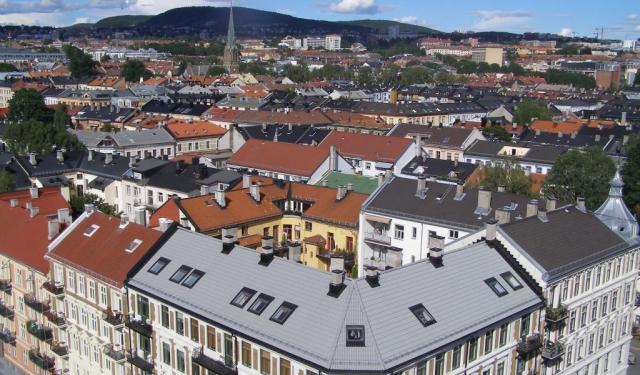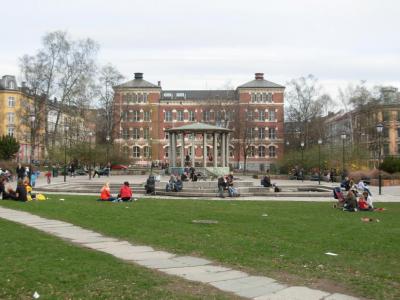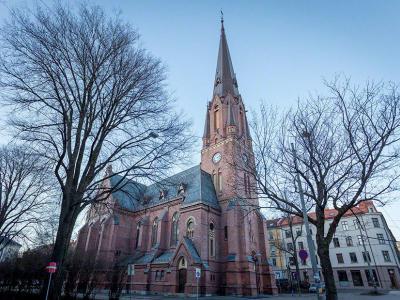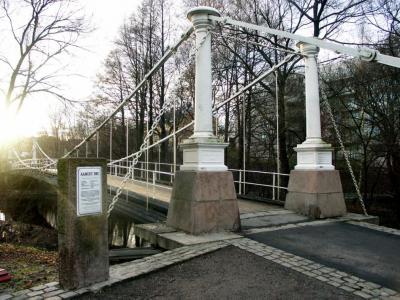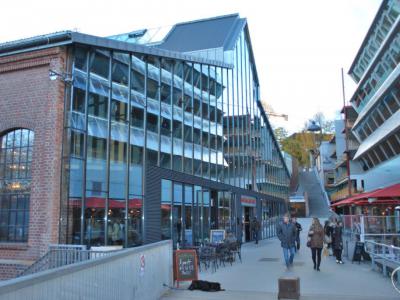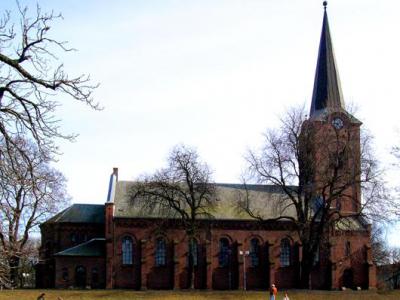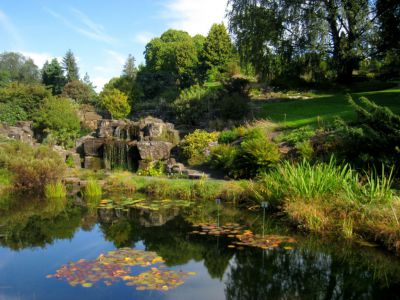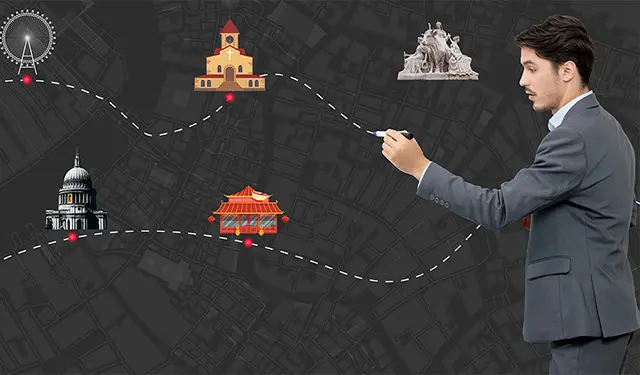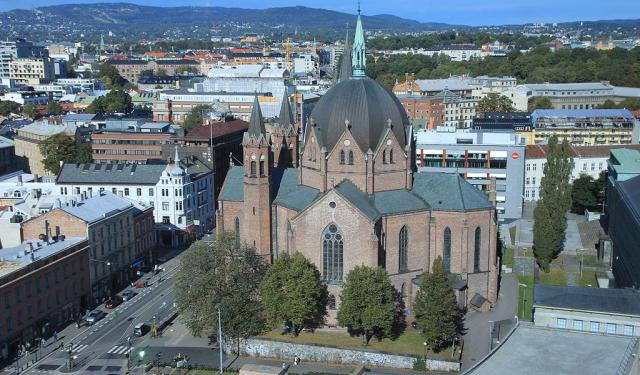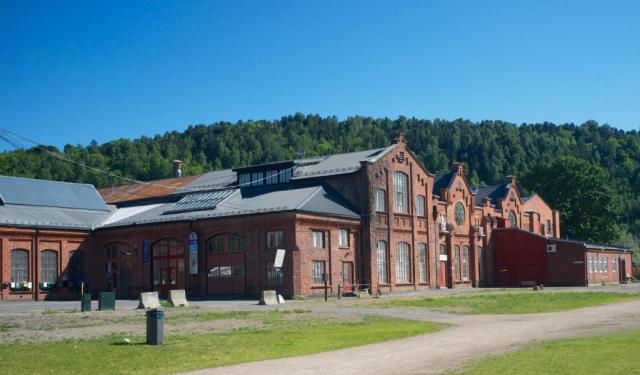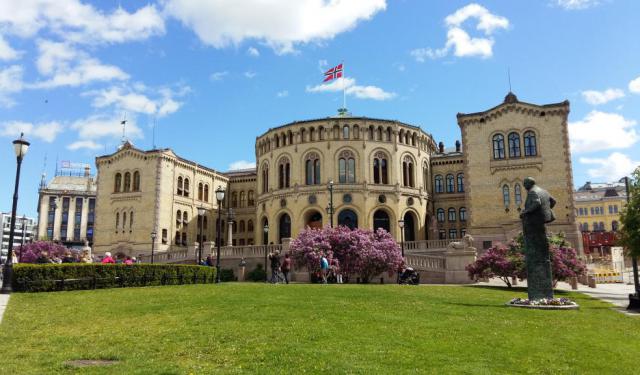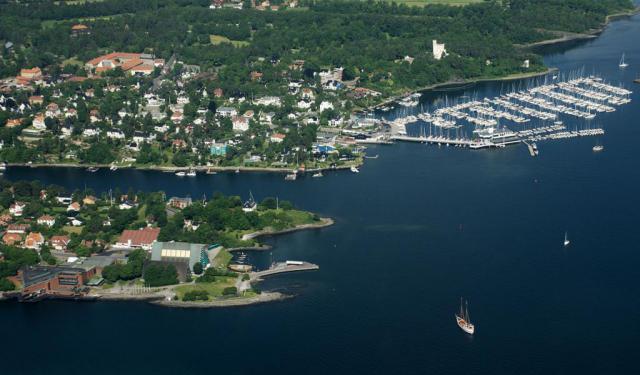Audio Guide: Grunerlokka Walking Tour (Self Guided), Oslo
Once a gritty, working-class corner of Oslo, Grunerlokka has undergone the classic glow-up-trading in factory soot for flat whites and vegan tacos. Named after Friedrich Gruner, a 17th-century city official who probably never imagined his name would one day grace a district with more tattoo parlors than churches, this neighborhood has turned from industrial to the capital’s cool kid on the block hangout-a place equal parts vintage vinyl, artisanal coffee, and street art with opinions...
This is where Norwegian roots tango with global flair, all thanks to a bit of late 20th-century gentrification and a whole lot of style. Think street art, rooftop bars, and enough indie cafes to make your barista cry tears of joy. But it’s not just about looking hip-Grunerlokka’s got substance too.
Wander through Birch Grove-yes, actual birch trees!-where the pace slows down and the air smells vaguely of poetry and pine needles. And if you're after something grander, look up: see that handsome silhouette on the skyline? That’s Paulus Church, standing tall with neo-Gothic pride, blessing the neighborhood with architectural drama.
For a scenic pause, check out Aamot Bridge-part connector, part Instagram backdrop, with scenic views over the meandering Akerselva River. Great for photos, better for kisses. Well, just saying...
Feeling hungry? Head straight to Mathallen Food Hall, where world cuisines line up like contestants on a reality cooking show-cheese from France, tacos from Mexico, and probably something involving fermented fish just to keep things authentically Norwegian.
For downtime, roll out a blanket in Sofienberg Park and stretch out on the grass, picnic like a pro, or admire the nearby Sofienberg Church-because there's no tastier way to say “culture” than by digesting brie in the shadow of history...
Science nerds and flower lovers, rejoice: the nearby University Botanical Garden and the Natural History Museum are ready to fill your head with Latin plant names and prehistoric beasts. Something for both your inner botanist and your five-year-old self.
Bottom line: Grunerlokka is Oslo’s all-you-can-experience buffet: stylish, green, tasty, and just the right amount of weird. So, bring your camera, your appetite, and maybe a tote bag-you’ll fit right in.
This is where Norwegian roots tango with global flair, all thanks to a bit of late 20th-century gentrification and a whole lot of style. Think street art, rooftop bars, and enough indie cafes to make your barista cry tears of joy. But it’s not just about looking hip-Grunerlokka’s got substance too.
Wander through Birch Grove-yes, actual birch trees!-where the pace slows down and the air smells vaguely of poetry and pine needles. And if you're after something grander, look up: see that handsome silhouette on the skyline? That’s Paulus Church, standing tall with neo-Gothic pride, blessing the neighborhood with architectural drama.
For a scenic pause, check out Aamot Bridge-part connector, part Instagram backdrop, with scenic views over the meandering Akerselva River. Great for photos, better for kisses. Well, just saying...
Feeling hungry? Head straight to Mathallen Food Hall, where world cuisines line up like contestants on a reality cooking show-cheese from France, tacos from Mexico, and probably something involving fermented fish just to keep things authentically Norwegian.
For downtime, roll out a blanket in Sofienberg Park and stretch out on the grass, picnic like a pro, or admire the nearby Sofienberg Church-because there's no tastier way to say “culture” than by digesting brie in the shadow of history...
Science nerds and flower lovers, rejoice: the nearby University Botanical Garden and the Natural History Museum are ready to fill your head with Latin plant names and prehistoric beasts. Something for both your inner botanist and your five-year-old self.
Bottom line: Grunerlokka is Oslo’s all-you-can-experience buffet: stylish, green, tasty, and just the right amount of weird. So, bring your camera, your appetite, and maybe a tote bag-you’ll fit right in.
How it works: Download the app "GPSmyCity: Walks in 1K+ Cities" from Apple App Store or Google Play Store to your mobile phone or tablet. The app turns your mobile device into a personal tour guide and its built-in GPS navigation functions guide you from one tour stop to next. The app works offline, so no data plan is needed when traveling abroad.
Grunerlokka Walking Tour Map
Guide Name: Grunerlokka Walking Tour
Guide Location: Norway » Oslo (See other walking tours in Oslo)
Guide Type: Self-guided Walking Tour (Sightseeing)
# of Attractions: 6
Tour Duration: 1 Hour(s)
Travel Distance: 2.5 Km or 1.6 Miles
Author: DanaOffice
Sight(s) Featured in This Guide:
Guide Location: Norway » Oslo (See other walking tours in Oslo)
Guide Type: Self-guided Walking Tour (Sightseeing)
# of Attractions: 6
Tour Duration: 1 Hour(s)
Travel Distance: 2.5 Km or 1.6 Miles
Author: DanaOffice
Sight(s) Featured in This Guide:
- Birch Grove
- Paulus Church
- Aamot Bridge
- Mathallen Food Hall
- Sofienberg Park and Church
- University Botanical Garden and Natural History Museum
1) Birch Grove
Welcome to the Birch Grove-Oslo’s leafy time capsule tucked right into the heart of Grünerløkka, where the past lounges comfortably on a park bench and watches the trams go by.
Originally part of the Aker municipality until Oslo decided to scoop it up in 1858, this patch of greenery got its revamp in the 1860s thanks to local mover-and-shaker Thorvald Meyer. He didn’t just develop the neighborhood-he gifted the park to the city in 1882.
By the 1920s, Birch Grove was flexing some flair: a music pavilion popped up in 1926, followed by a chic little pool a couple of years later. And it’s not just pretty-monuments here pack a punch, including one that honors Norwegian volunteers who fought in the Spanish Civil War.
All around, the park is flanked by buildings that look like they’ve seen things-most built in the late 1800s. You've got Grünerløkka School from 1895 on the one side and Paulus Church from 1892 on the other, both standing like proud grandparents watching over the kids playing in the grass.
Then came 2006, when Oslo practically declared: “Hands off!” A major preservation plan kicked in, covering the park, the school, the church, and fifteen surrounding blocks, banning all visible changes. It was the first time Norway’s Ministry of the Environment officially wrapped its arms around a whole urban cultural environment. And yes, it was kind of a big deal.
Today, strolling the streets around Birch Grove is like flipping through a photo album where the architecture doesn’t just pose-it tells stories. So, take your time. Walk slow. Oslo’s got layers, and they’re particularly lovely here.
Originally part of the Aker municipality until Oslo decided to scoop it up in 1858, this patch of greenery got its revamp in the 1860s thanks to local mover-and-shaker Thorvald Meyer. He didn’t just develop the neighborhood-he gifted the park to the city in 1882.
By the 1920s, Birch Grove was flexing some flair: a music pavilion popped up in 1926, followed by a chic little pool a couple of years later. And it’s not just pretty-monuments here pack a punch, including one that honors Norwegian volunteers who fought in the Spanish Civil War.
All around, the park is flanked by buildings that look like they’ve seen things-most built in the late 1800s. You've got Grünerløkka School from 1895 on the one side and Paulus Church from 1892 on the other, both standing like proud grandparents watching over the kids playing in the grass.
Then came 2006, when Oslo practically declared: “Hands off!” A major preservation plan kicked in, covering the park, the school, the church, and fifteen surrounding blocks, banning all visible changes. It was the first time Norway’s Ministry of the Environment officially wrapped its arms around a whole urban cultural environment. And yes, it was kind of a big deal.
Today, strolling the streets around Birch Grove is like flipping through a photo album where the architecture doesn’t just pose-it tells stories. So, take your time. Walk slow. Oslo’s got layers, and they’re particularly lovely here.
2) Paulus Church
Tucked into the artsy heart of Grünerløkka, right across from the leafy calm of Birch Grove Park, Paulus Church has been keeping watch over Oslo since 1892. Built from solid brick and blessed with some serious German Gothic flair, it’s the kind of place that reaches for the heavens-quite literally-with a spire so slim and tall it could double as a lightning rod for divine inspiration.
Designed by architect Henrik Bull back in 1889, the church comfortably fits about 500 souls-give or take a sermon. Over the years, it's had a few facelifts, most notably in 1917 and again in 1972, proving that even churches need the occasional glow-up...
Step inside and you’ll find an altarpiece that’s more “Nordic elegance” than over-the-top Baroque. Crafted from brown-stained pine, trimmed in gold, and split into three panels, it features some celestial brasswork by Jo Visdalen-trumpeting angels, no less-flanked by two paintings by Christen Brun. Nestled in between is a plaster Christ figure, calm and composed as ever, sculpted by Gunnar Olsen Alvær in 1894.
And don’t forget the organ: a majestic piece by German organ builder Albert Hollenbach, custom-made for the church’s opening. It’s been filling the space with rich tones since day one-because what’s a Gothic church without a little musical drama?
So, be it a concert, a quiet moment, or just some top-tier architectural admiration that you're here for, Paulus Church hits all the right notes.
Designed by architect Henrik Bull back in 1889, the church comfortably fits about 500 souls-give or take a sermon. Over the years, it's had a few facelifts, most notably in 1917 and again in 1972, proving that even churches need the occasional glow-up...
Step inside and you’ll find an altarpiece that’s more “Nordic elegance” than over-the-top Baroque. Crafted from brown-stained pine, trimmed in gold, and split into three panels, it features some celestial brasswork by Jo Visdalen-trumpeting angels, no less-flanked by two paintings by Christen Brun. Nestled in between is a plaster Christ figure, calm and composed as ever, sculpted by Gunnar Olsen Alvær in 1894.
And don’t forget the organ: a majestic piece by German organ builder Albert Hollenbach, custom-made for the church’s opening. It’s been filling the space with rich tones since day one-because what’s a Gothic church without a little musical drama?
So, be it a concert, a quiet moment, or just some top-tier architectural admiration that you're here for, Paulus Church hits all the right notes.
3) Aamot Bridge
Gracefully suspended over Oslo’s Aker River in the artsy Grünerløkka district, the Aamot Bridge is strictly for those on foot or two wheels only. But don’t be fooled by its quiet demeanor; this bridge has lived a few lives.
Originally built way back in 1851–1852, it started out nowhere near Oslo, but over the Drammen River in Buskerud, right where the Simoa River joins in at Åmot. Back then, cast iron chains-produced by the Nes Ironworks factory-held it all together, making it one of Norway’s earliest chain-hanger bridges. Not bad for a 19th-century engineering experiment...
Eventually, time took its toll, and the old bridge was replaced. But instead of being scrapped, it got a second act: shipped off to Oslo like a prized antique, disassembled bolt by bolt and reassembled along the Aker in 1952. It was meant to serve as a grand gateway to a Technical Museum that (plot twist!) ended up being built somewhere else. So the bridge stayed behind, retired from vehicular duty, now blissfully catering to walkers and cyclists.
A cheeky inscription still warns would-be marchers: "I can bear a hundred men, but falter during the rhythmic march." Translation – don’t think of starting a parade here...
Originally built way back in 1851–1852, it started out nowhere near Oslo, but over the Drammen River in Buskerud, right where the Simoa River joins in at Åmot. Back then, cast iron chains-produced by the Nes Ironworks factory-held it all together, making it one of Norway’s earliest chain-hanger bridges. Not bad for a 19th-century engineering experiment...
Eventually, time took its toll, and the old bridge was replaced. But instead of being scrapped, it got a second act: shipped off to Oslo like a prized antique, disassembled bolt by bolt and reassembled along the Aker in 1952. It was meant to serve as a grand gateway to a Technical Museum that (plot twist!) ended up being built somewhere else. So the bridge stayed behind, retired from vehicular duty, now blissfully catering to walkers and cyclists.
A cheeky inscription still warns would-be marchers: "I can bear a hundred men, but falter during the rhythmic march." Translation – don’t think of starting a parade here...
4) Mathallen Food Hall
If your stomach can't make up its mind-and let's face it, whose can?-Mathallen Food Hall is your deliciously trusty culinary compass in the heart of the Vulkan district. The area’s pedestrian-friendly charm pairs nicely with a walk to the nearby Vulkan Arena or a scenic wander down Oslo’s own “Trail of Love.”
With over 30 specialty shops, cafés, and eateries all tempting you with everything from Norwegian classics to global street eats, this buzzing indoor market is a full-blown flavor rodeo and a choose-your-own-adventure where the prize is always edible.
Feeling adventurous? Start with Hungarian goulash so rich, it practically sings folk songs. Nibble your way through the refined Southeast Asian plates at Atelier Asian Tapas, then give your inner Viking a nod with the wild game dishes at Helt Vilt.
And in case you're still hungry, there’s artisanal cheese that bites back, cured meats that whisper of smoke and tradition, and dreamy chocolate (which, come to think of it, should probably be illegal), not to mention enough craft drinks to wash it all down.
All of this unfolds inside a lovingly restored early 1900s industrial building perched along the scenic Akerselva River. It’s got just the right amount of rustic charm to make your Instagram jealous. Regardless of whether you're grazing now or stockpiling for later, there’s a stall ready to feed your cravings or future self.
Operating Tuesday through Sunday (because even food halls need a nap on Mondays), Mathallen is open from 10 am to 8 pm. Alternatively, you can swing by on Sundays between 11 and 6. Just be warned: once here, your taste buds may never want to leave...
With over 30 specialty shops, cafés, and eateries all tempting you with everything from Norwegian classics to global street eats, this buzzing indoor market is a full-blown flavor rodeo and a choose-your-own-adventure where the prize is always edible.
Feeling adventurous? Start with Hungarian goulash so rich, it practically sings folk songs. Nibble your way through the refined Southeast Asian plates at Atelier Asian Tapas, then give your inner Viking a nod with the wild game dishes at Helt Vilt.
And in case you're still hungry, there’s artisanal cheese that bites back, cured meats that whisper of smoke and tradition, and dreamy chocolate (which, come to think of it, should probably be illegal), not to mention enough craft drinks to wash it all down.
All of this unfolds inside a lovingly restored early 1900s industrial building perched along the scenic Akerselva River. It’s got just the right amount of rustic charm to make your Instagram jealous. Regardless of whether you're grazing now or stockpiling for later, there’s a stall ready to feed your cravings or future self.
Operating Tuesday through Sunday (because even food halls need a nap on Mondays), Mathallen is open from 10 am to 8 pm. Alternatively, you can swing by on Sundays between 11 and 6. Just be warned: once here, your taste buds may never want to leave...
5) Sofienberg Park and Church
Sofienberg Park-Oslo’s most scenic plot twist. It may look like your average green retreat-but dig a little deeper (pun intended), and you'll find it has a rather grave backstory. Literally.
Spanning 180 acres in the city's northeast, this leafy area began its days in 1858 not as a picnic haven, but as a cemetery. In the early 20th century, as the city sprawled, most of the 60,000 graves here were gently relocated elsewhere. All except for the Jewish Cemetery, which today still quietly keeps the park's original purpose alive beneath its calm greenery.
But don’t let that history spook you-Sofienberg has had quite the second life, with picnic tables, cheerful playgrounds, and even a few ping-pong tables-because nothing says leisure like a brisk rally over what used to be sacred ground.
At the heart of the park stands Sofienberg Church, a red-brick beauty consecrated in 1877 and designed by Jacob Wilhelm Nordan. Inside, you'll find a luminous altarpiece by Otto Sinding and stained glass windows by Maria Vigeland and Enevold Thomt-artistic heavyweights who knew how to catch the light just right. Thanks to its heavenly acoustics, the church also moonlights as a concert venue, giving you a reason to visit even when the weather isn’t picnic-friendly.
You may come to the park for the ping-pong, but stay for the stained glass, and enjoy the unexpected charm of the area that went from eternal rest to eternal recreation...
Spanning 180 acres in the city's northeast, this leafy area began its days in 1858 not as a picnic haven, but as a cemetery. In the early 20th century, as the city sprawled, most of the 60,000 graves here were gently relocated elsewhere. All except for the Jewish Cemetery, which today still quietly keeps the park's original purpose alive beneath its calm greenery.
But don’t let that history spook you-Sofienberg has had quite the second life, with picnic tables, cheerful playgrounds, and even a few ping-pong tables-because nothing says leisure like a brisk rally over what used to be sacred ground.
At the heart of the park stands Sofienberg Church, a red-brick beauty consecrated in 1877 and designed by Jacob Wilhelm Nordan. Inside, you'll find a luminous altarpiece by Otto Sinding and stained glass windows by Maria Vigeland and Enevold Thomt-artistic heavyweights who knew how to catch the light just right. Thanks to its heavenly acoustics, the church also moonlights as a concert venue, giving you a reason to visit even when the weather isn’t picnic-friendly.
You may come to the park for the ping-pong, but stay for the stained glass, and enjoy the unexpected charm of the area that went from eternal rest to eternal recreation...
6) University Botanical Garden and Natural History Museum
Oslo’s leafy brainchild, the University Botanical Garden, was founded back in 1814 by the University of Oslo-because, indeed, a “serious academic institution” sounds better if fitted with 7,500 plants... All these specimens aren’t just for show-they’re enlisted in the noble missions of science, conservation, and giving visitors an excuse to say words like “gymnosperm” in public.
Wandering the grounds, you’ll bump into Toyen Manor, a stately wooden relic with serious seniority-it’s the oldest building in the university’s care and quite possibly the oldest timber structure in Oslo. Inside, you’ll find rotating exhibits and a cozy café, perfect for contemplating your place in the ecosystem over a cinnamon bun.
Sharing the spotlight is the Natural History Museum, Norway’s largest of its kind, where prehistoric skeletons, glittering minerals, and climate education await. Don’t miss the world’s oldest complete primate skeleton-or as we like to call it, your ancient cousin with excellent posture...
The whole ensemble is tucked into Toyen Park, just west of the Edvard Munch Museum. The best part is that the garden's entry is free all week. And if you time your visit for Thursday, all the indoor exhibits are free too. So, go on-embrace your inner botanist, climate warrior, or curious mammal and enjoy yourself.
Wandering the grounds, you’ll bump into Toyen Manor, a stately wooden relic with serious seniority-it’s the oldest building in the university’s care and quite possibly the oldest timber structure in Oslo. Inside, you’ll find rotating exhibits and a cozy café, perfect for contemplating your place in the ecosystem over a cinnamon bun.
Sharing the spotlight is the Natural History Museum, Norway’s largest of its kind, where prehistoric skeletons, glittering minerals, and climate education await. Don’t miss the world’s oldest complete primate skeleton-or as we like to call it, your ancient cousin with excellent posture...
The whole ensemble is tucked into Toyen Park, just west of the Edvard Munch Museum. The best part is that the garden's entry is free all week. And if you time your visit for Thursday, all the indoor exhibits are free too. So, go on-embrace your inner botanist, climate warrior, or curious mammal and enjoy yourself.
Walking Tours in Oslo, Norway
Create Your Own Walk in Oslo
Creating your own self-guided walk in Oslo is easy and fun. Choose the city attractions that you want to see and a walk route map will be created just for you. You can even set your hotel as the start point of the walk.
Historical Churches Walking Tour
Oslo's religious landscape, particularly within the Christian tradition, is a captivating tapestry interwoven with history, faith, and architectural elegance. The city boasts a collection of historical churches reflecting the evolution of local Christian communities. Diverse in their designs, these sacred sites offer a glimpse into the deep-rooted religious traditions that have shaped Oslo... view more
Tour Duration: 1 Hour(s)
Travel Distance: 1.2 Km or 0.7 Miles
Tour Duration: 1 Hour(s)
Travel Distance: 1.2 Km or 0.7 Miles
Old Oslo Walking Tour
The historic Old Town of Oslo is the oldest part of the city which dates back to the days of medieval Norway. This urban area emerged around the year 1000 and became the capital of Norway's dominion (within the Dano-Norwegian Realm) around 1300. The Old Town district continued to be known as Oslo, while the whole city was called Christiania, until 1925.
One of its prominent landmarks is... view more
Tour Duration: 1 Hour(s)
Travel Distance: 1.4 Km or 0.9 Miles
One of its prominent landmarks is... view more
Tour Duration: 1 Hour(s)
Travel Distance: 1.4 Km or 0.9 Miles
Oslo Introduction Walking Tour
Originally a Viking village, Norway's capital city has a long and multifaceted history that begins long before its establishment as a trading hub of Ánslo in 1040 AD. Archaeological findings suggest the presence of a Christian settlement in the area predating the year 1000.
Throughout the Middle Ages, Oslo's significance varied under the rule of Danish and Norwegian kings. Around... view more
Tour Duration: 2 Hour(s)
Travel Distance: 4.1 Km or 2.5 Miles
Throughout the Middle Ages, Oslo's significance varied under the rule of Danish and Norwegian kings. Around... view more
Tour Duration: 2 Hour(s)
Travel Distance: 4.1 Km or 2.5 Miles
Museum District (Bygdoy) Walking Tour
Oslo's Museum District, located on the Bygdoy Peninsula, is home to some of the most visited museums in the city. Repositories of precious artifacts from Norway’s history, these remarkable institutions collectively represent a treasure trove for those keen on exploring this northerly nation's past.
One of the standout attractions here is the Fram Museum, showcasing the incredible... view more
Tour Duration: 2 Hour(s)
Travel Distance: 3.1 Km or 1.9 Miles
One of the standout attractions here is the Fram Museum, showcasing the incredible... view more
Tour Duration: 2 Hour(s)
Travel Distance: 3.1 Km or 1.9 Miles
Useful Travel Guides for Planning Your Trip
Traveler's Choice: 15 Norwegian Gifts from Oslo
The Norwegians are strict about gift making and believe that each gift must be equaled with a return one. For this reason, public holidays and birthdays are a very serious business in Norway, with everyone making and receiving gifts. In the spirit of this tradition, you might want to treat your dear...
The Most Popular Cities
/ view all
